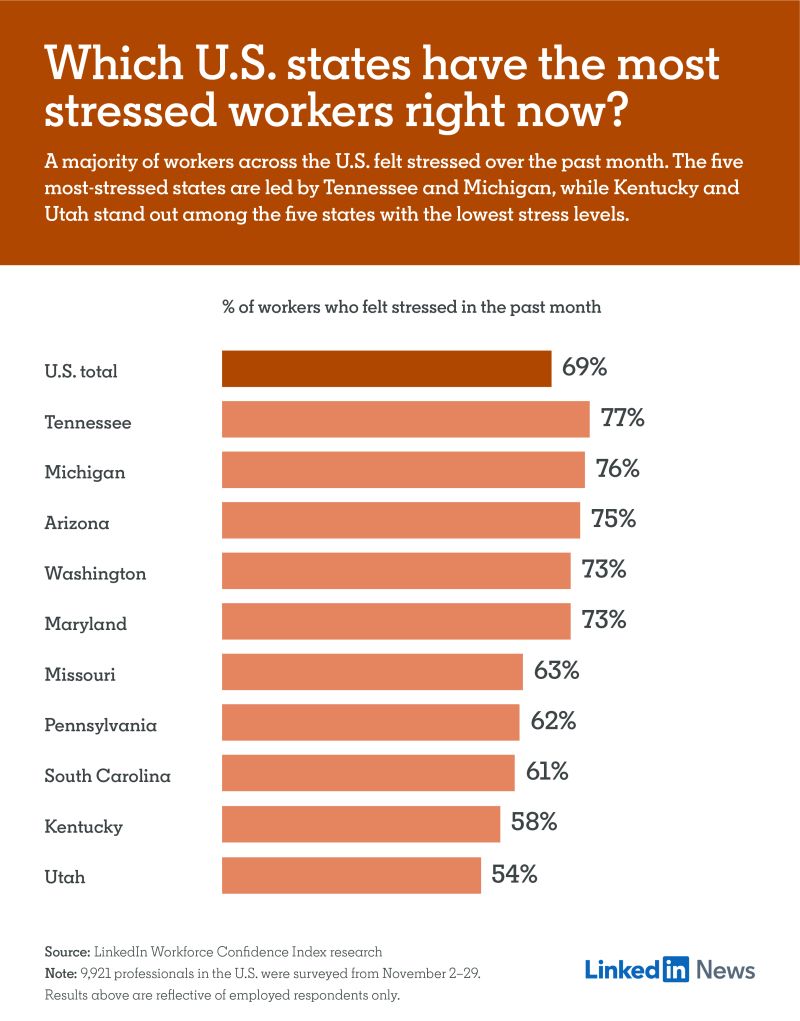According to a recent poll from LinkedIn’s Workforce Confidence Index, nearly 70% of workers across the nation said they felt stressed over the past month. However, there are big variations depending on where you live, how much you earn, and which generation you belong to.

Tennessee leads the nation with 77 percent of the state’s workforce indicating they have felt stressed over the past month. This is consistent with other findings, including a national household pulse survey by the Centers for Disease Control and Prevention, released in September, that showed Tennessee as the state with the highest rates of anxiety and depression among adults. Economic pressures have also increased in Tennessee over the past few months, as indicated by a 0.9 percentage point jump to the state’s unemployment rate in October, which stood at 7.4 percent.
Although the unemployment rate in Michigan has continued to drop over the past several months, standing at 5.1 percent as recently as October, the state ranked second for worker stress (76%) in LinkedIn’s latest poll. The state’s COVID-10 positivity rate ranked 27th in the nation this week, with a rate of 11.2 percent, and ranked 21st in the CDC’s household pulse survey with just over 24 percent of the population reporting feelings of anxiety or depression over the past week.
At the other end of the spectrum, Utah emerged as the least-stressed state (54%). Its October unemployment rate held steady at 4.1%, barely half the national average. However, Utah’s COVID-19 case rate has been among the 10 highest in the U.S. (on a per 100,000 population basis), which could impact the state’s outlook going forward.
Stress varies greatly across generations
In conjunction with stress related to health care, the economy, racism, and the presidential election — stress from COVID-19 is seriously threatening the mental health of our country, particularly among low-income workers, parents, and our youngest generation, according to an October survey from the American Psychological Association.
Nearly 8 in 10 adults reported the coronavirus pandemic was a significant source of stress in their lives (78%), while 3 in 5 indicated that the number of issues Americans face were overwhelming to them (60%). On a scale from 1 to 10 — with 1 meaning “little to no stress” and 10 meaning “a great deal of stress” — the average stress level among all adults was 5.0. However, the average Gen Z adult said their stress level during the prior month hovered at 6.1.
Changes to school are a predominate driver of the negative feelings among Gen Z teens and adults. Over 4 in 5 Gen Z teens ages 13 to 17 reported experiencing negative impacts of pandemic-related school closures (81%), and just over half said the pandemic made planning for their future feel impossible (51%). Like teens, 2 in 3 Gen Z adults in college said the pandemic made planning for their future feel impossible (67%), while 87 percent of Gen Z adults in college reported that education was a significant source of stress in their lives.
The survey also suggested that most Americans are not getting the support they need. The majority of adults said they could have used more emotional support than they received over the prior 12 months (61%), with more than 8 in 10 Gen Z adults reporting the same (82%).
The following strategies can be utilized by educators and parents to support the mental health and well-being of Gen Z youth and adults:
- Create meaningful opportunities for connections with family, culture and community. Although many have left home physically, these connections remain fundamental to youth well-being.
- Create traditions for Gen Z that celebrate milestones in new ways. They can be the generation that reinvents society by creating new celebrations and traditions that are meaningful.
- Facilitate access to mental health services during and after the pandemic. This can include telehealth services, interstate psychological services and increasing funding to better support mental health services provided within schools when this is over.
- Provide educational, work, training and employment opportunities specifically targeted at supporting this generation of young adults. They need to see a possible path forward for themselves.
- Thank our youngest generation for the sacrifices they’ve made for the greater good. This includes social involvement that is critical to their development, milestones such as graduations and proms, and even their education. We should acknowledge what they and many others are doing to keep us safe.
Stress varies significantly by income
Although employed adults were equally likely to report work as a source of stress in both 2019 and 2020 (64%), the share of employed adults who reported that job stability was a source of stress was 6 percent higher in 2020 (56%). Nearly 2 in 3 adults (64%) said that money was a significant source of stress in their life and just over half of adults (52%) indicated they have experienced negative financial impacts due to the pandemic.
Among adults who were employed at some point during the pandemic, 68 percent reported their job or employment had been negatively impacted by the pandemic. The most commonly reported impacts were reductions in hours (19%), balancing household responsibilities during work time (14%), being laid off (14%), or experiencing decreased productivity (14%). Adults who were employed during the pandemic with a household income less than $50,000 were almost twice as likely to experience a layoff than those with a household income greater than $50,000 (21% vs. 11%).
Additionally, 73 percent of low-income adults reported that money was a significant source of stress, compared to just 5 percent for those in higher income brackets. When looking at households that are at or below the federal poverty level, this disparity widens (79% vs. 57% of those above the poverty level). Further, nearly 3 in 5 adults with a household income less than $50,000 cited housing costs (e.g., mortgage or rent) as a significant source of stress in their life (58%), compared to 44 percent of those with higher incomes.
The following strategies can be utilized by employers to support the mental health and well-being of their employees:
- Provide flexibility to employees, whether it’s what they work on, when they work or how they work (how they work is particularly important for employers of frontline workers). Every single person has been impacted by the pandemic; providing flexibility at work will allow people to do their jobs while still being able to handle new stressors and responsibilities in their lives, such as a child’s education.
- Provide support. This can be emotional support through one-on-one check-ins or by reducing someone’s workload to just essential tasks. This also applies to co-workers, who can support each other by checking in and approaching each other with empathy.
- Provide clear communication to employees and supervisors about expectations, support resources and new policies that respond directly to impacts created by the pandemic. This reduces uncertainty at work, which is a major contributor to employee stress.
- Supervisors should not expect work to continue at the same level as before. Creating this expectation can lead to employee burn-out. Instead, help employees prioritize what work is critical and what can wait.
Without progress to restore jobs and industries that were displaced due to the pandemic, widespread efforts to upskill and retrain the disparate share of low-skill adults who lost jobs in these industries, and improved accessibility and affordability of childcare to increase labor force participation and reduce the burden among working parents, it is likely the trajectory of these disparities will not improve.
{{cta(‘d60ba4b7-35ab-4063-b38f-075d8956d281′,’justifycenter’)}}


